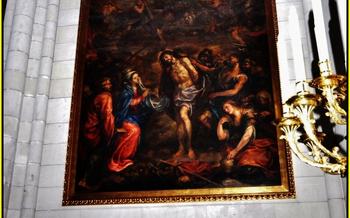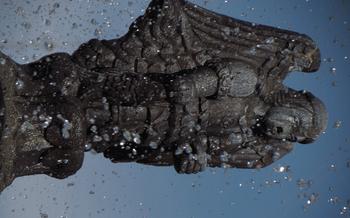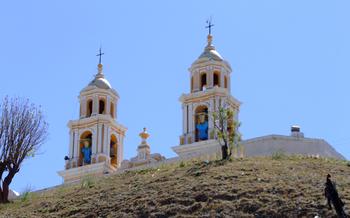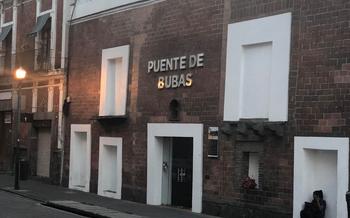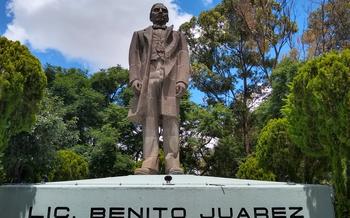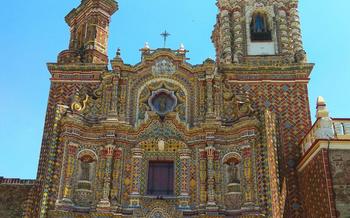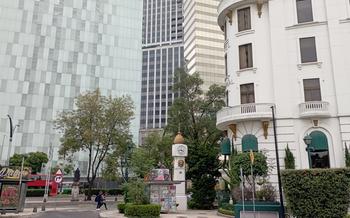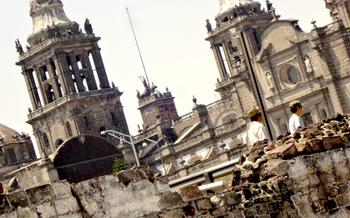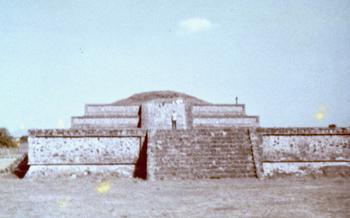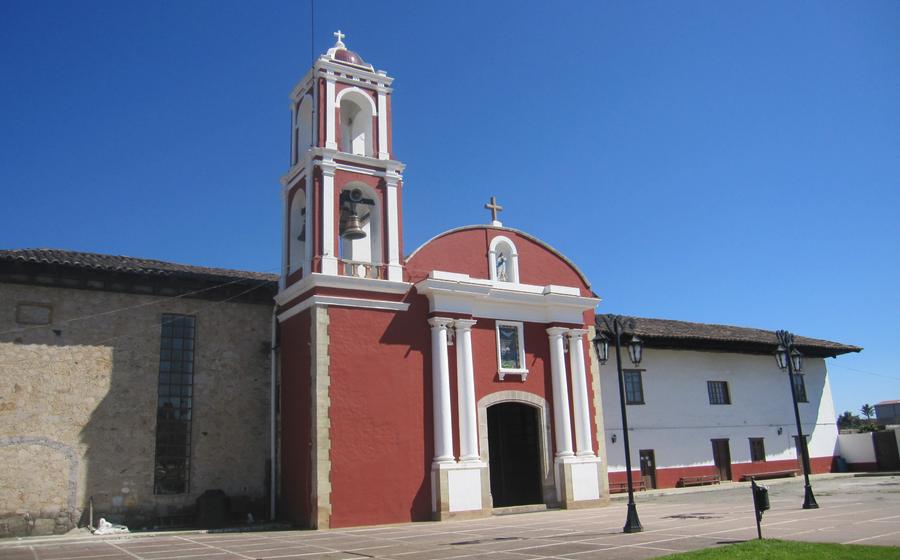
Centro Cultural Santa Rosa
- Museo Internacional del Barroco
- Biblioteca Palafoxiana
- Plaza de la Concordia
- Callejón de los Sapos: Where Magic and Shopping Converge
- Casa de los Muñecos
- Fuerte de Loreto
- Mercado El Parián: A Vibrant Tapestry of Commerce and Culture
- Zona Arqueológica de Cholula
- Capilla Real
- Parque del Paseo Bravo: A Haven of Tranquility in the Heart of has been captivating locals and visitors alike for centuries. With its verdant gardens, meticulously manicured lawns, and an array of enchanting fountains, this historic park offers a sanctuary of serenity amidst the vibrant energy of Puebla.
- Insider Tip: Explore the Barrio del Artista
Museo Internacional del Barroco
The Museo Internacional del Barroco (MIB) is an architectural marvel that pays homage to the Baroque movement with its distinctive design. This masterpiece, conceptualized by Japanese architect Toyo Ito, seamlessly blends the elements of light, water, and geometry, creating a breathtaking symphony of visual artistry. Within its walls, the museum houses an impressive collection of Mexican and international Baroque art, showcasing paintings, sculptures, and decorative arts that capture the essence of this dynamic period.
To enhance your MIB experience, plan your visit to coincide with one of the museum's special events or workshops. These immersive programs offer a deeper dive into the Baroque era, allowing you to engage with the art and history in a truly memorable way. During my visit, I was mesmerized by a Baroque-inspired concert that filled the museum's grand halls with enchanting melodies, making it a truly unforgettable experience.
Biblioteca Palafoxiana
The Biblioteca Palafoxiana stands as a testament to5,000 volumes, including rare books, manuscripts, and maps dating back to the 16th century.
The library's collection is boasts an impressive collection of maps and engravings, offering a glimpse into the geographical knowledge and artistic sensibilities of the time.
To delve into the library's treasures, visitors can request access to the reading room, where they can peruse the collection under the watchful eye of the library's knowledgeable staff. Researchers and scholars are particularly encouraged to visit, as the library provides a wealth of primary source material for historical and cultural studies.
During my visit to the Biblioteca Palafoxiana, I was particularly captivated by a rare edition of "El Quijote," published in Madrid in 160The book's worn leather cover and faded ink hinted at the countless hands that had held it over the centuries. As I turned the delicate pages, I couldn't help but feel a connection to the past, imagining the scholars and students who had pored over these same pages, seeking knowledge and inspiration.
A visit to the Biblioteca Palafoxiana is a must for anyone interested in history, literature, or the preservation of cultural heritage. Its collection is a testament to the enduring power of the written word and the importance of libraries as repositories of knowledge.
Plaza de la Concordia
The Plaza de la Concordia is the heart of Puebla, a vibrant gathering place and the stage for numerous social and political events throughout history. The plaza's significance extends beyond its function as a meeting point; it is a testament to Puebla's rich architectural heritage. The surrounding buildings showcase a harmonious blend of colonial and contemporary styles, each contributing to the plaza's unique character.
The Palacio Municipal, with its grand facade and intricate detailing, stands as a symbol of civic authority. The Templo de San Pedro, with its soaring spires and ornate facade, adds a touch of religious grandeur to the plaza. The buildings that line the plaza's perimeter boast unique architectural features, from intricate iron balconies to colorful Talavera tiles, creating a visually captivating streetscape.
The plaza's energy is infectious, with locals and tourists alike congregating to soak up the atmosphere. Street performers entertain the crowds, vendors sell traditional snacks, and children play amidst the fountains and sculptures. Whether you're sipping coffee at a sidewalk cafe, enjoying a leisurely stroll, or simply basking in the vibrant atmosphere, the Plaza de la Concordia offers an authentic taste of Puebla's charm.
In the evenings, the plaza transforms into a lively hub of activity. The lights illuminate the buildings, casting a warm glow over the square, and the air fills with the sounds of music and laughter. It's the perfect place to experience Puebla's vibrant nightlife, with bars, restaurants, and live music venues offering a variety of entertainment options.
One of my favorite memories of the Plaza de la Concordia is attending a traditional Mexican concert held in the plaza. The stage was set up in front of the Palacio Municipal, and the crowd gathered in anticipation. The music was infectious, and everyone was dancing and singing along. It was a magical moment, and I felt a deep connection to the city and its people.
Whether you're a history buff, an architecture enthusiast, or simply looking for a place to soak up the local vibe, the Plaza de la Concordia is a must-visit destination in Puebla.
Callejón de los Sapos: Where Magic and Shopping Converge
Theoretical:
The Callejón de los Sapos, or Alley of the Toads, holds a captivating history that dates back to the pre-Hispanic era, when it served as a market for indigenous goods. Its association with witchcraft and magic emerged much later, giving it an air of mystery and intrigue.
Informative:
As you stroll through this narrow alley, you'll be greeted by a vibrant array of shops and stalls, each brimming with unique and enchanting items. From intricate handicrafts and souvenirs to magical talismans and potions, the Callejón de los Sapos is a treasure trove for those seeking extraordinary finds. Take your time to browse through the stalls, where you'll discover intricately carved wooden sculptures, colorful hand-painted ceramics, and shimmering dreamcatchers.
Practical:
To make the most of your shopping experience, remember to hone your bargaining skills. The vendors here are known for their friendly banter and willingness to negotiate. Don't hesitate to engage in a bit of bargaining, as it's all part of the fun and can lead to some great deals.
Anecdotal:
Among the many captivating items I discovered in the Callejón de los Sapos, one particular artifact stood out—a beautifully crafted obsidian skull. Intrigued by its enigmatic presence, I struck up a conversation with the vendor, who shared fascinating stories about its supposed mystical properties. Whether or not you believe in magic, there's no denying the allure of this enchanting alleyway, where the boundaries of reality seem to blur, and the spirit of Puebla's rich history comes alive.
Casa de los Muñecos
The Casa de los Muñecos is a must-visit for anyone interested in Puebla's rich history and architecture. This magnificent 17th-century building is named after the Talavera tiles that adorn its facade, depicting scenes from mythology and everyday life. Inside, the museum houses a collection of decorative arts and furniture from the 17th and 18th centuries, offering a glimpse into the opulent lifestyle of Puebla's elite during the colonial period.
Theoretical: The Casa de los Muñecos is a prime example of the Baroque architectural style that flourished in Puebla during the 17th and 18th centuries. Its intricate facade, featuring Talavera tiles, sculptures, and wrought-iron balconies, is a testament to the skill and artistry of the local craftsmen. The building's interior is equally impressive, with its grand staircase, ornate plasterwork, and colorful tilework.
Informative: The museum's collection includes a variety of decorative arts and furniture from the 17th and 18th centuries, including paintings, sculptures, ceramics, and furniture. Visitors can admire the exquisite craftsmanship of the Talavera tiles, which depict scenes from mythology, everyday life, and religious iconography. The museum also houses a collection of furniture from the colonial period, including elaborately carved chests, chairs, and tables.
Practical: The Casa de los Muñecos is located in the historic center of Puebla, a short walk from the Zócalo. The museum is open Tuesday through Sunday from 10:00 am to 5:00 pm. Admission is free. Guided tours are available in Spanish and English.
Anecdotal: During my visit to the Casa de los Muñecos, I was particularly drawn to a large Talavera tile depicting a scene from the Battle of Puebla. The tile, which was created in the 19th century, commemorates the Mexican victory over the French army in 186I was impressed by the skill and artistry of the tile maker, who had captured the drama and intensity of the battle in such intricate detail.
Fuerte de Loreto
The Fuerte de Loreto, also known as the Fort of Loreto, is a magnificent testament to the rich and storied history of Puebla. This imposing fortress, built between 1670 and 1740, stands as a silent sentinel, guarding the city against potential attacks from indigenous groups and marauding pirates who once threatened the region.
As you approach the fort, you will be struck by its sheer size and imposing presence. Its thick walls, towering over the city, are a testament to the engineering skill and military prowess of the Spanish colonizers. The fort's strategic location on a hilltop provides breathtaking panoramic views of Puebla and the surrounding countryside.
Once inside the fort, you can explore its labyrinthine network of tunnels and chambers, which were used to store ammunition, provisions, and other supplies. These tunnels also served as a safe haven for soldiers and civilians during times of conflict. The fort's well-preserved ramparts and watchtowers offer visitors a glimpse into the lives of the soldiers who once manned this important defensive structure.
One of the fort's most striking features is its 18th-century chapel, which is adorned with intricate frescoes and carvings. The chapel is a testament to the spiritual beliefs of the soldiers who served here, and it is a poignant reminder of the importance of faith in times of war and conflict.
Visiting the Fuerte de Loreto is an unforgettable experience that transports you back in time to a period of great upheaval and strife. It is a place where you can learn about Puebla's rich history and appreciate the ingenuity and resilience of its people.
Mercado El Parián: A Vibrant Tapestry of Commerce and Culture
Theoretical:
Mercado El Parián holds a significant place in the heart of Puebla, serving as a bustling hub of commerce and cultural exchange. This vibrant marketplace has played a pivotal role in shaping the city's identity, attracting locals and tourists alike with its vibrant atmosphere and diverse offerings.
Informative:
Strolling through the labyrinthine alleys of Mercado El Parián, visitors are greeted by a kaleidoscope of colors and sounds. The market's colorful stalls overflow with an array of traditional crafts, textiles, and mouthwatering delicacies. From intricate Talavera pottery to finely woven textiles, shoppers can find a treasure trove of unique souvenirs to take home.
Practical:
To fully embrace the market's charm, visitors should come prepared to engage in the art of bargaining. Friendly haggling is a customary practice that allows shoppers to secure the best prices for their desired items. Additionally, visitors should wear comfortable shoes and clothing, as navigating the market's narrow passageways can involve a lot of walking.
Anecdotal:
During my visit to Mercado El Parián, I stumbled upon a small stall selling traditional Mexican masks. Intrigued by their intricate designs and vibrant colors, I couldn't resist striking up a conversation with the friendly vendor. As we chatted, he shared fascinating stories about the cultural significance of each mask, bringing the market's vibrant atmosphere to life.
Zona Arqueológica de Cholula
Theoretical: The Zona Arque the most important archaeological sites in Mexico. It is home to the Great Pyramid of Cholula, also known as Tlachihualtepetl, which is the largest pyramid in the Americas by volume. The pyramid was built by the Olmecs and later expanded by the Toltecs and Aztecs. It is believed to have been a religious center and a place of pilgrimage for ancient Mesoamerican cultures.
Informative: The Great Pyramid of Cholula is an impressive sight, rising over 60 meters high and covering an area of over 5 square kilometers. It is constructed from adobe bricks and has a complex system of tunnels and chambers inside. The pyramid is surrounded by a number of smaller pyramids and other structures, including temples, palaces, and workshops.
Practical: The Zona Arqueológica de Cholula is open to the public daily from 9am to 5pm. Admission is 70 pesos for adults and 55 pesos for children. Guided tours are available in Spanish and English. The site is accessible by public transportation from Puebla or by taxi.
Anecdotal: I visited the Zona Arqueológica de Cholula on a clear day, and the views from the top of the pyramid were breathtaking. I could see for miles in every direction, and the surrounding countryside was lush and green. It was an amazing experience to stand on top of such an ancient and important structure and to imagine the people who had built it and worshipped there centuries ago.
Capilla Real
Amidst the vibrant tapestry of Puebla's colonial architecture, the Capilla Real stands as a testament to the city's rich history of solemnity and sacredness.
The interior of the chapel is a symphony of Baroque splendor, with its ornate altar, intricate carvings, and colorful tiles creating a visually stunning spectacle. The altar, a masterpiece of Churrigueresque artistry, is adorned with intricate carvings depicting biblical scenes and angelic figures, while the walls are adorned with vibrant tiles depicting the life of Christ.
Beyond its architectural and artistic significance, the Capilla Real holds deep religious significance for the people of Puebla. It is here that the remains of Don Juan de Palafox y Mendoza, a revered figure in the city's history, are laid to rest. His tomb, a grand and imposing structure, serves as a constant reminder of his legacy and the enduring faith of the people of Puebla.
For visitors seeking a moment of spiritual reflection or a glimpse into Puebla's rich religious heritage, the Capilla Real is an essential destination. Whether you are drawn to its architectural beauty, its historical significance, or its sacred atmosphere, the chapel promises an experience that is both awe-inspiring and profoundly moving.
Practical Tips:
- Dress code: Visitors are expected to dress respectfully when visiting the Capilla Real. Avoid wearing shorts, tank tops, or revealing clothing.
- Visiting hours: The chapel is open to the public from 9:00 am to 6:00 pm, Tuesday through Sunday.
- Guided tours: Guided tours of the chapel are available in Spanish and English. Check with the tourist information office for details.
- Photography: Photography is permitted inside the chapel, but flash photography is not allowed.
Parque del Paseo Bravo: A Haven of Tranquility in the Heart of has been captivating locals and visitors alike for centuries. With its verdant gardens, meticulously manicured lawns, and an array of enchanting fountains, this historic park offers a sanctuary of serenity amidst the vibrant energy of Puebla.
As you stroll along the cobblestone paths, let the fragrant scent of roses, jasmine, and bougainvillea lead you to hidden corners and secluded benches. Take a moment to pause by the cascading fountains, their gentle rhythm creating a soothing symphony that invites contemplation. Admire the intricate details of the sculptures that adorn the park, each one a testament to the artistic heritage of Puebla.
Whether you seek solace, inspiration, or simply a place to bask in the warmth of the Mexican sun, Parque del Paseo Bravo has something for every soul. Join joggers and cyclists as they trace the park's winding paths, or find a shady spot beneath a majestic tree to lose yourself in a captivating book.
As the day transitions into twilight, the park transforms into a magical realm illuminated by twinkling lights. Take a leisurely stroll hand-in-hand with your loved one, or gather with friends for a memorable picnic under the starry sky.
Parque del Paseo Bravo is not just a park; it is a cherished part of Puebla's cultural fabric, a place where memories are made and cherished. Embrace the tranquility of this urban haven, and let its beauty and serenity seep into your soul.
Insider Tip: Explore the Barrio del Artista
For an authentic and vibrant experience of Puebla's art scene, head to the Barrio del Artista. This charming neighborhood, located just a short walk from the historic center, is home to a thriving community of artists, galleries, and studios. Stroll through the cobblestone streets, admire the colorful murals, and pop into the galleries to discover unique artworks and crafts. You can also catch live music performances, theater productions, and art exhibitions in the neighborhood's many cultural venues. Don't miss the opportunity to interact with local artists and learn about their creative process. Whether you're an art enthusiast or simply looking for a unique and inspiring experience, the Barrio del Artista is a must-visit in Puebla.
